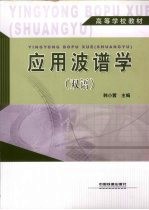
- 作 者:韩小茜主编
- 出 版 社:北京:中国铁道出版社
- 出版年份:2008
- ISBN:9787113089252
- 标注页数:246 页
- PDF页数:256 页
请阅读订购服务说明与试读!
订购服务说明
1、本站所有的书默认都是PDF格式,该格式图书只能阅读和打印,不能再次编辑。
2、除分上下册或者多册的情况下,一般PDF页数一定要大于标注页数才建议下单购买。【本资源256 ≥246页】
图书下载及付费说明
1、所有的电子图书为PDF格式,支持电脑、手机、平板等各类电子设备阅读;可以任意拷贝文件到不同的阅读设备里进行阅读。
2、电子图书在提交订单后一般半小时内处理完成,最晚48小时内处理完成。(非工作日购买会延迟)
3、所有的电子图书都是原书直接扫描方式制作而成。
Chapter 1 Ultraviolet and Visible Spectroscopy 1
1.1 Introduction 1
1.2 The Principles of Ultraviolet and Visible Spectroscopy 4
1.3 Electronic Transitions and Chromophore 11
1.4 Solvent Effects 13
1.5 Empirical Rules for Absorption Wavelengths of Conjugated Systems 14
1.6 Applications of UV Spectroscopy in Organic Structure Determination 28
Problems 30
New Words and Expressions 33
第1章 紫外可见光谱法 36
1.1 概述 36
1.2 紫外可见光谱原理 37
1.3 电子跃迁与生色团 39
1.4 溶剂效应 41
1.5 共轭体系吸收波长的经验规则 42
1.6 紫外可见光谱在有机化合物结构测定中的应用 42
Chapter 2 Infrared Spectroscopy 43
2.1 Introduction 43
2.2 Instrument and IR Samples 43
2.3 Theory of Infrared Spectroscopy 46
2.4 Infrared Spectra of Different Organic Compounds 55
2.5 Interpreting IR Spectra 69
Problems 78
New Words and Expressions 87
第2章 红外吸收光谱法 90
2.1 概述 90
2.2 红外光谱仪和红外样品处理 90
2.3 红外光谱的基本原理 91
2.4 各类有机化合物的红外光谱 95
2.5 红外吸收光谱法的应用 96
Chapter 3 Nuclear Magnetic Resonance Spectroscopy 98
3.1 Nuclear Spin States 98
3.2 Nuclear Magnetic Moments 99
3.3 The Chemical Shift and Shielding 101
3.4 The Nuclear Magnetic Resonance Spectrometer 104
3.5 Chemical Equivalence-A Brief Overview 104
3.6 Integrals and Integration 106
3.7 The Chemical Environment and the Chemical Shift 107
3.8 Local Diamagnetic Shielding 108
3.9 Magnetic Anisotropy 111
3.10 Spin-spin Splitting(n+1)Rule 113
3.11 The Coupling Constant 117
3.12 The Second-order Spectra 118
3.13 Aromatic Compounds 119
3.14 Interpretation of 1H NMR Spectra 122
3.15 Carbon-13 Nuclear Magnetic Resonance Spectroscopy 124
3.16 A Deeper Look:Calculation of 13C Chemical Shifts 130
Problems 137
New Words and Expressions 145
第3章 核磁共振波谱 147
3.1 核磁共振的基本原理 147
3.2 影响化学位移的因素 148
3.3 自旋偶合及自旋裂分 150
3.4 氢核磁共振谱图及其提供的信息 153
3.5 核磁共振波谱仪 155
3.6 碳-13的核磁共振波谱 155
Chapter 4 Mass Spectrometry 158
4.1 Introduction 158
4.2 Ionization Techniques 159
4.3 Determination of the Molecular Formula by Mass Spectrometry 168
4.4 The Mass Spectra of Organic Compounds 175
4.5 Interpretation to Mass Spectrometry 211
4.6 Interpretation of Four Spectra for the Identification of Organic Compounds 217
Problems 224
New Words and Expressions 230
第4章 质谱 233
4.1 概述 233
4.2 质谱分析的基本原理和质谱仪 233
4.3 质谱确定分子式 234
4.4 各类有机化合物的质谱 235
4.5 质谱解析 237
4.6 四谱的应用 237
Answers to Problems 238
Bibliography 246
